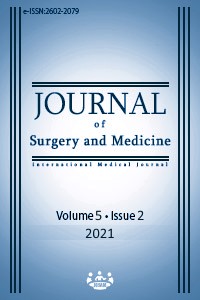Do embryo transfer catheters affect pregnancy success?
Keywords:
Catheter, Embryo transfer, Pregnancy rate, Assisted reproductive medicineAbstract
Background/Aim: In-vitro fertilization-embryo transfer requires meticulous technique. To minimize endometrial trauma and perform the procedure as delicately as possible, various catheters are used for embryo transfer. In this study, we aimed to determine whether pregnancy rate is affected by the softness of those catheters. A standard catheter is not preferred in clinics. We wanted to see how pregnancy success would be affected if we made the catheter a constant variable. Methods: A retrospective cohort study was conducted with the participation of 149 patients in Acibadem University Atakent Hospital IVF Unit. We used Wallace (Smith Medical) semi-rigid catheters and Labotect (Labor-Technik-Göttingen) flexible catheters (divided into two groups). Patients between 28-35 years of age, with infertility without known causes or who had mild male factors and received Gn-RH antagonist treatment protocol were included in this study. Patients with azoospermic partners, tubal factors and severe ovarian failure were excluded. Results: There were no statistically significant differences between the patients who got pregnant and those who did not in terms of age, basal FSH, duration of infertility, antral follicle count and endometrial thickness before transfer. The pregnancy rates after transfer in the semi-rigid (Group 1) and soft catheter (Group 2) groups were 43,5% and 56,5%, respectively (P=0.108). Conclusions: In our study, the pregnancy rates were higher in transfers performed with a soft catheter. Soft catheter positively affects pregnancy success. However, it is difficult to say that this alone affects pregnancy success.
Downloads
References
Sallam HN. Embryo transfer: factors involved in optimizing the success. Curr Opin Obstet Gynecol. 2005;17:289-98.
Buckett WM. A review and meta-analysis of prospective trials comparing different catheters used for embryo transfer. Fertil Steril. 2006;85:728-34.
Montag M, Toth B, Strowitzki T. New approaches to embryo selection. Reproductive Biomedicine Online. 2019;27:539-46.
Tesarik J, Pilka L, Dvorak M, Travnik P. Oocyte recovery, in vitro insemination and transfer into the oviduct after its microsurgical repair at a single laparotomy. Fertil Steril. 1983;39:472–5.
Devroey P, Braeckmans P, Smitz J, Van Waesberghe, L, Wisanto A, Van Steirteghem A, et al. Pregnancy after trans laparoscopic zygote intrafallopian transfer in a patient with sperm antibodies. Lancet. 1986;1:1329.
Society for Assisted Reproductive Technology, American Society for Reproductive Medicine. Assisted reproductive technology in the United States: 2001 results generated from the American Society for Reproductive Medicine/Society for Assisted Reproductive Technology registry. Fertil Steril. 2007;87:1253–66.
Poncelet C, Sifer C, Hequet D, Porcher R, Wolf JP, Uzan M, et al. Hysteroscopic evaluation of endocervical and endometrial lesions observed after different procedures of embryo transfer: A prospective comparative study. Eur J Obstet Gynecol Reprod Biol. 2009;147:183–6.
Ruhlmann C, Gnocchi DC, Cattaneo AR, Molina LG, Rivadeneira LR, Tessari L, et al. Embryo Transfer Catheters: Softer is Easier. JBRA Assist Reprod. 2015;19:204-9.
Omidi M, Halvaei I, Mangoli E, Khalili MA, Razi MH. The effect of embryo catheter loading technique on the live birth rate. Clin Exp Reprod Med. 2015;42:175-80.
Abou-Setta AM, Al-Inany HG, Mansour RT, Serour GI, Aboulghar MA. Soft versus firm embryo transfer catheters for assisted reproduction: A systematic review and meta-analysis. Hum Reprod. 2005;20:3114–21.
Yao Z, Vansteelandt S, Van Der Elst J, Coetsier T, Dhont M, De Sutter P. The efficacy of the embryo transfer catheter in IVF and ICSI is operator-dependent: A randomized clinical trial. Hum Reprod. 2009;24:880–7.
Hearns-Stokes RM, Miller BT, Scott L, Creuss D, Chakraborty PK, Segars JH. Pregnancy rates after embryo transfer depend on the provider at embryo transfer. Fertil Steril. 2000;74:80–6.
Kovacs GT. What factors are important for successful embryo transfer after in-vitro fertilization? Hum Reprod. 1999;14:590–2.
Salha OH, Lamb VK, Balen AH. A postal survey of embryo transfer practice in the UK. Hum Reprod. 2001;16:686–90.
Rhodes TL, Higdon HL 3rd, Boone WR. Comparison of pregnancy rates for two embryo-transfer catheters. Fertil Steril. 2007; 87:411-6.
McIlveen M, Lok FD, Pritchard J, Lashen H. Modern embryo transfer catheters and pregnancy outcome: a prospective randomized trial. Fertil Steril. 2005;84:996.
Drakeley A, Jorgensen A, Sklavounos J, Aust T, Gazvani R, Williamson P, et al. A randomized controlled clinical trial of 2295 ultrasound-guided embryo transfers. Hum Reprod. 2008;23:1101–6.
Downloads
- 524 797
Published
Issue
Section
How to Cite
License
Copyright (c) 2021 Elif Ganime Aygün, Talat Umut Kutlu Dilek
This work is licensed under a Creative Commons Attribution-NonCommercial-NoDerivatives 4.0 International License.
















